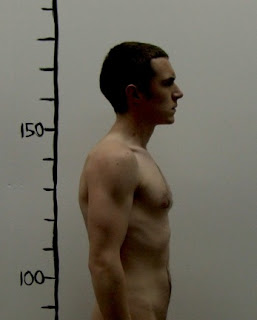
Bodily Modification Program (BMP), 2008. Installation of project artefacts, data and results for Sydney College of the Arts' Honours Graduation Exhibition 2010.
BODILY MODIFICATION PROGRAM (BMP) (2008)
Bodily Modification Program (BMP) documents a six-month experimental study (hereafter referred to as ‘the project’) of the role of body modification practices in performance art. It began with a statement of intent; “to assess the impact of bodily modification upon the performance artwork”. Rather than approaching this brief theoretically, the project was to be undertaken experimentally. It was determined that a series of modifications would be enacted upon the artist’s body (the Bodily Modification Program). Undertaken simultaneously, a series of performances would test the impact of the modifications (the Performance Program). The development of the Performance Program would operate independently of the Bodily Modification Program. To maintain objectivity and generate reproducible results, the performances were not to be conceived of with a conscious eye towards the modifications they were to test. Performances would be analysed reflectively to determine the impact of the concurrent body modifications upon their reading. These would be cross referenced against the results of ongoing physical condition testing, to determine whether the nature and degree of modification reflected the results of the post-performance analysis.
It is important to note that the project did not set out to study body modification inperformance art but rather body modification for performance art. This is, in effect, to apply a sporting model to performance practice. Just as the athlete trains for sporting competition, the project was to determine the viability of training for the performance artwork. In determining the type of body modification to undertake it therefore seemed natural to use physical fitness practices. Using sports science resources a training regime was designed. The regime, segmented into four-week blocks, was enacted as follows:
Test Battery 4: Body Shots, digital photographs
1) cardiovascular fitness
2) flexibility, cardiovascular fitness
3) strength and muscle mass, flexibility, cardiovascular fitness
4) body fat minimisation, strength and muscle mass, flexibility, cardiovascular fitness
5) tapering of training intensity
6) reversal of all training gains
(The two final blocks were designed to offer a comparison to the escalating intensity of the first four). The artist trained six days per week for between one and four hours.
Test Battery Four: Body Shot (anterior), 2008.
The project’s final analysis offered neutral results. Whilst physical condition testing demonstrated that the training regime had been effective and the artist’s body had been modified dramatically this was not reflected in the analysis of performances. Apart from minor instances in individual works, the modifications could not be seen to produce major impacts upon the conceptual composition of the performances undertaken. It was concluded that body modification in a training format was not a viable approach to performance practice. It appears that body modification is only of conceptual value to the artwork when incorporated directly as is the normative approach.



No comments:
Post a Comment